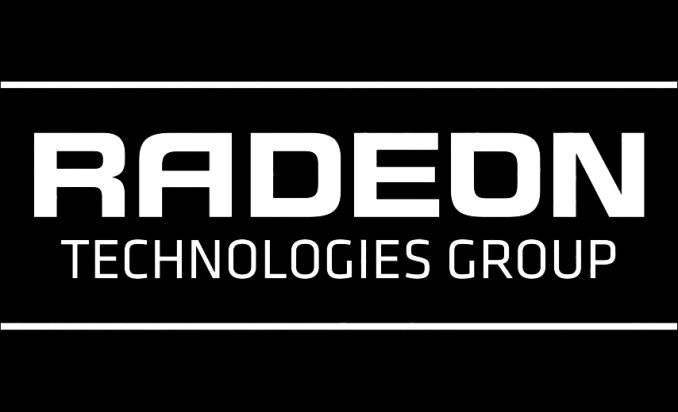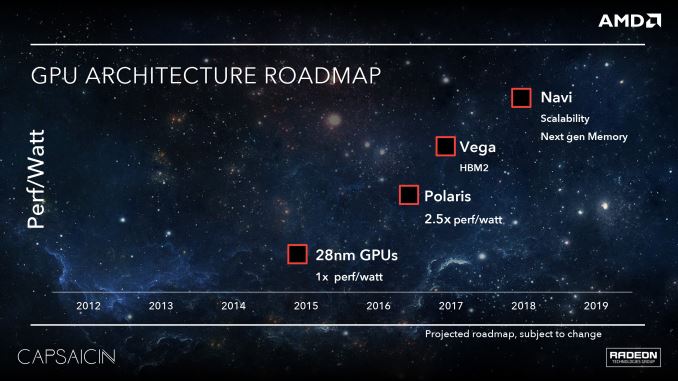AMD Unveils GPU Architecture Roadmap: After Polaris Comes Vega
by Ryan Smith on March 15, 2016 3:30 AM EST
Although AMD’s GDC 2016 “Capsaicin” event was primarily focused on game development – it is the Game Developers Conference, after all – AMD did spend a brief moment discussing their future GPU plans. For the first time in many years, AMD has published a GPU architecture roadmap.
Plotting perf/watt against the years, AMD’s roadmap unveils two new architectures: Vega, and Navi. Essentially everything there is to know about these architectures is in this slide – AMD is being tight-lipped regarding further details – but this map gives us some tantalizing new information to work with.
Vega is currently scheduled to come relatively quickly after Polaris. Depending on how literal you interpret this chart, the far left edge of the Vega box does fall into 2016, though obviously AMD intends to leave themselves some wiggle room here and not tie themselves down to specific dates. The fact that Vega comes this soon after Polaris is interesting; it seems hard to believe that it’s a direct successor to Polaris – I can’t see AMD replacing Polaris parts in less than a year – so this points to Vega being more of a cousin, and is where AMD’s naming system isn’t especially helpful in deciphering anything further.
With Polaris confirmed to use GDDR5, Vega is notable for being the first AMD architecture to use HBM2, and the first parts in general to use HBM tech since Fiji. I’m presuming these are higher-end GPUs to complement the Polaris GPUs (the smaller of which we know to be a low-power laptop design), which is where HBM would be more cost-effective, at least at current prices.
Meanwhile AMD has also confirmed the number of GPUs in the Vega stack and their names. We’ll be seeing a Vega 10 and a Vega 11. This follows Polaris GPU naming – which has finally been confirmed – with Polaris 10 and Polaris 11. I have also been told that Polaris 11 is the smaller of the Polaris GPUs, so at this point it’s reasonable to assume the same for Vega.
Finally, farther out towards 2018 is an architecture AMD is calling Navi. This one I suspect will attract the most attention (even if it’s the farthest out) due to the ambiguity of its features: “scalability” and “next gen memory”. Similar to how it’s hard to see Vega directly replacing Polaris, it’s hard to see Navi directly replacing Vega after only a year. This leaves Navi rife for speculation; I could very well see it being a Polaris replacement since we’ll be nearly 2 years past Polaris, or perhaps something to do with AMD’s APU plans. Either way I don’t expect that this will be the last time AMD teases it before finally launching it.

















54 Comments
View All Comments
Spunjji - Wednesday, March 16, 2016 - link
Explain to me the difference between an optimistic conclusion based on faulty inferences and a bet? xDsmilingcrow - Monday, March 21, 2016 - link
$$$$$$$$$$$$$$$$$$iAMD - Tuesday, March 15, 2016 - link
i'm already working on 0.00000000000001 nmdsraa - Tuesday, March 15, 2016 - link
I agree, AMD historically in the past has trailed right on the heels of intel's cpus, and for a good discount\performance ratio. It's a good buisness model, and they do it well. I know exactly what you are gonna say, that they are bleeding money out the A$$, but I like that they are continuing to try and be competitive even at lower price points.So yes, I don't see them dumping a ton of R&D into skipping 10mm and going straight to 7mm, it just doesn't seem like it makes sense financially, and honestly, I think it makes MORE sense for them to take little steps, rather than a jump forward. It's too big of a gamble for them to do that.
Jimster480 - Tuesday, March 15, 2016 - link
Well I mean if you look at what they have done with FX.... They left FX on 32nm and are now going to 14nm. Because its cheaper that way to squeeze as much as possible out of each node. Which is why it would make sense to skip 10 and wait for 7.name99 - Wednesday, March 16, 2016 - link
TSMC current roadmap assumed 7nm "risk production" at the end of 2017.My guess is Apple puts the A10 on 16nmFF+, 2017's A11 on 10nm, and then MAYBE (this would be really aggressive) 2018's A12 on 7nm. But A12 production has to start about 9 months before iPhones ship to build up inventory, so that's crazy tight. Which means more likely 2019's A13 gets 7nm.
Reason Apple is relevant in all this is that Apple so far gets first dibs at everything new and good at TSMC. (It would not surprise me if this is, by now, contractual --- Apple pays part of developing the new process, but then gets 6 months exclusive use or whatever.)
I think it would be astonishing if AMD (or anyone else of significance) shipped a chip, especially a chip the size of serious GPUs, before Apple gets its shipments out.
iwod - Tuesday, March 15, 2016 - link
Unless something dramatic changes in the industry, GPU will never be using the leading node anytime soon. Those capacity are reserved for Mobile SoC only. So even in 2018 it is likely to be 10nm.TSMC 7nm at the end of 2018 will very likely be Apple SoC only.
jayfang - Tuesday, March 15, 2016 - link
SoC's have GPU's too, thus 7nm GPU designsNot just a smart comment => if Navi is scalable then it may also target Mobile SoC's
SaberKOG91 - Tuesday, March 15, 2016 - link
This is a common misconception with process size. Just because the process has a process size of 7nm, this doesn't mean that every part of the design is or even can be the minimum feature size. Going from one FinFET process to the next means that an old 14nm might not even need to be shrunk in any way to be produced under a 7nm process. Now, of course they will optimize what they can, but AMD is a shining example of designers continually improving designs on the same process node.III-V - Tuesday, March 15, 2016 - link
Ah, that "new to tech" optimism. You clearly haven't been following manufacturing process rollouts long enough. Also, 2016 (14 nm GPU launch date) + 2 years (typical time between nodes) = 2018.Unless 7nm is something incredibly watered down and thus abnormally quick to market... you couldn't be more wrong.